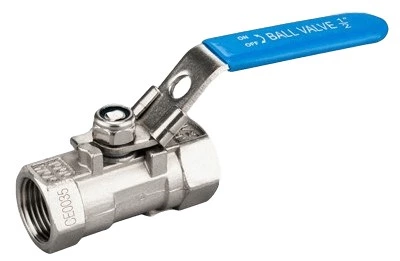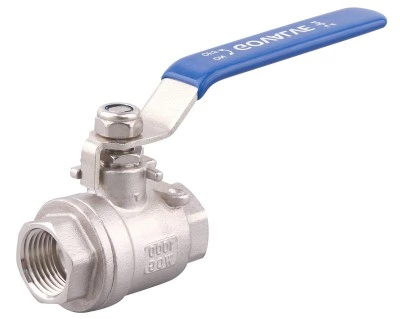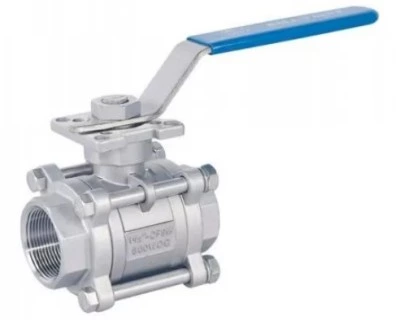The differences between one-piece, two-piece, and three-piece ball valves
What is a one-piece ball valve:
A one-piece ball valve is called so because its valve body has an integral structure, which makes it compact and lightweight. The ball, seat, and stem are installed from one side of the valve body, but due to the size limitation of the valve body, the full-flow diameter ball cannot be installed inside, so the flow path of a one-piece ball valve is reduced in diameter. Its flow capacity is limited. It has certain advantages in terms of cost and is mainly used in low-pressure pipelines.
One-piece ball valves have threaded connections, flanged connections, and clamp connections. Threaded connections usually use 55° taper pipe threads to achieve better sealing performance. Flanged connections are convenient to install. Clamp connections have a shorter structure length and can be installed on compact space pipelines.
The valve is made of materials such as WCB cast steel, stainless steel CF8, CF8M, etc.
Due to the shallow packing chamber of the one-piece threaded ball valve and the less amount of sealing packing, it is often used in low-pressure pipelines.
The one-piece flanged ball valve can be made into a high temperature drain valve to effectively prevent the medium from leaking out of the valve body, avoiding the risk of medium leakage between the valve body of a two-piece or three-piece ball valve. It can be used for steam, heat transfer oil medium. It can also be made into an insulated ball valve to transport crystallizing and solidifying media. Hot water and steam are introduced into the insulation shell to provide insulation for the ball valve.

What is a two-piece ball valve:
The valve body of a two-piece ball valve is composed of a main body and an auxiliary body, hence the name two-piece ball valve. It is a commonly used type of ball valve. After installing the ball, seat, and stem in the main body, the auxiliary body is connected to the main body through threads or bolts. Its ball passage is of full-flow diameter, resulting in lower flow resistance and larger flow capacity.
Two-piece ball valves also have internal threaded connections, external threaded connections, and internal and external threaded connections. Threaded connections typically use 55° taper pipe threads for better sealing. Flanged connections of two-piece ball valves are widely used.

What is a three-piece ball valve:
The valve body of a three-piece ball valve consists of a main body and two auxiliary bodies, hence the name three-piece ball valve. After installing the ball and stem in the main body, the auxiliary bodies are placed in the seats and are connected to the main body through bolts. Its ball passage is also of full-flow diameter.
Three-piece ball valves also have internal threaded connections, external threaded connections. Internal threads usually use 55° taper pipe threads for better sealing. The external thread has a welded joint, which can be welded to the pipeline. It is easier to disassemble and assemble during maintenance, avoiding the need for a separate live connection for internal threaded connections.
For welding and socket welding connections, extended pipe fittings can be used to prevent damage to the seat seals and stem packing during high-temperature welding, reducing the difficulty of installation.
The main feature of a three-piece ball valve is the ability to be maintained online, which is very convenient. By loosening the screws on the valve body, removing a bolt passing through the main body, the main body can be rotated to replace the seat seals. The main body can also be completely removed by removing the bolts, without having to dismantle the entire ball valve, greatly reducing the maintenance workload.

The differences between one-piece, two-piece, and three-piece ball valves:
-
The valve body structures are different. One-piece ball valves have integral valve bodies, two-piece ball valves have main and auxiliary valve bodies, and three-piece ball valves have one main body and two auxiliary bodies.
-
The ball passage sizes differ. One-piece ball valves have reduced diameter flow paths, which affect their flow capacity. Two-piece and three-piece ball valves have full-flow diameter flow paths, resulting in lower flow resistance and larger flow capacity. If there are flow requirements, two-piece or three-piece ball valves should be selected.
-
The workload for installation and maintenance differs. Three-piece ball valves are more convenient to install and maintain than one-piece and two-piece ball valves, with less workload. They are convenient for replacing seat seals, ball cores, packings, and other components.
-
The cost of procurement differs. Among valves of the same specifications, three-piece ball valves have the highest cost, followed by two-piece ball valves, and one-piece ball valves have the lowest cost.